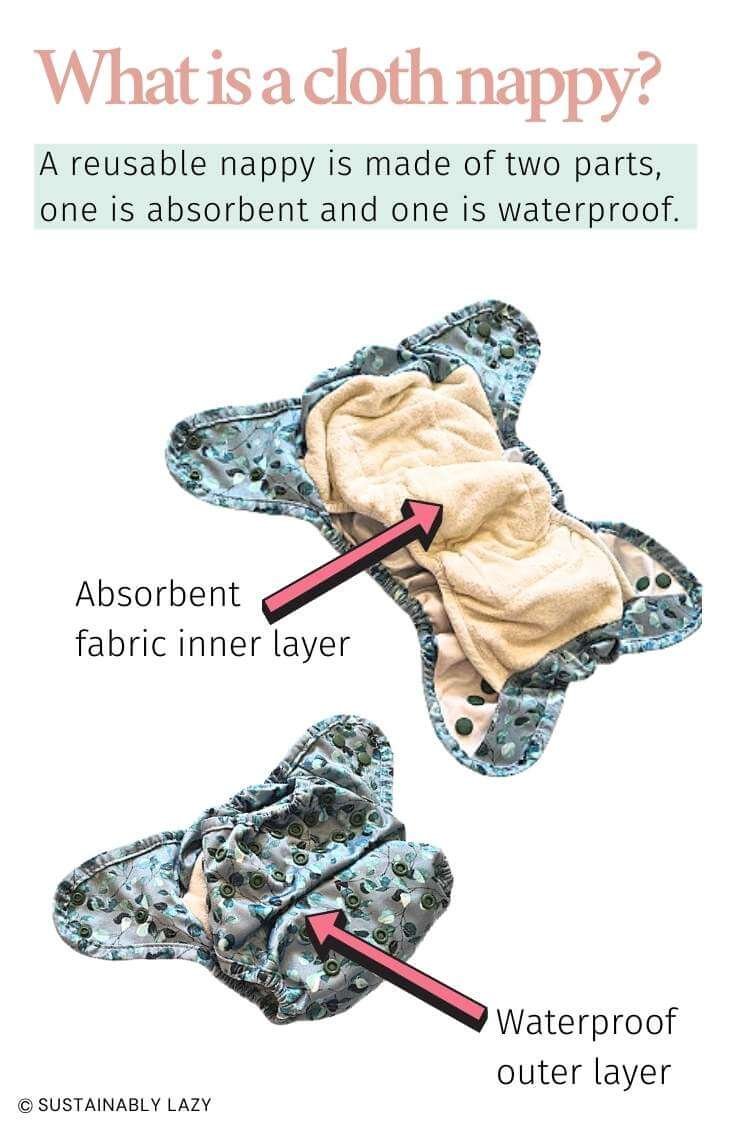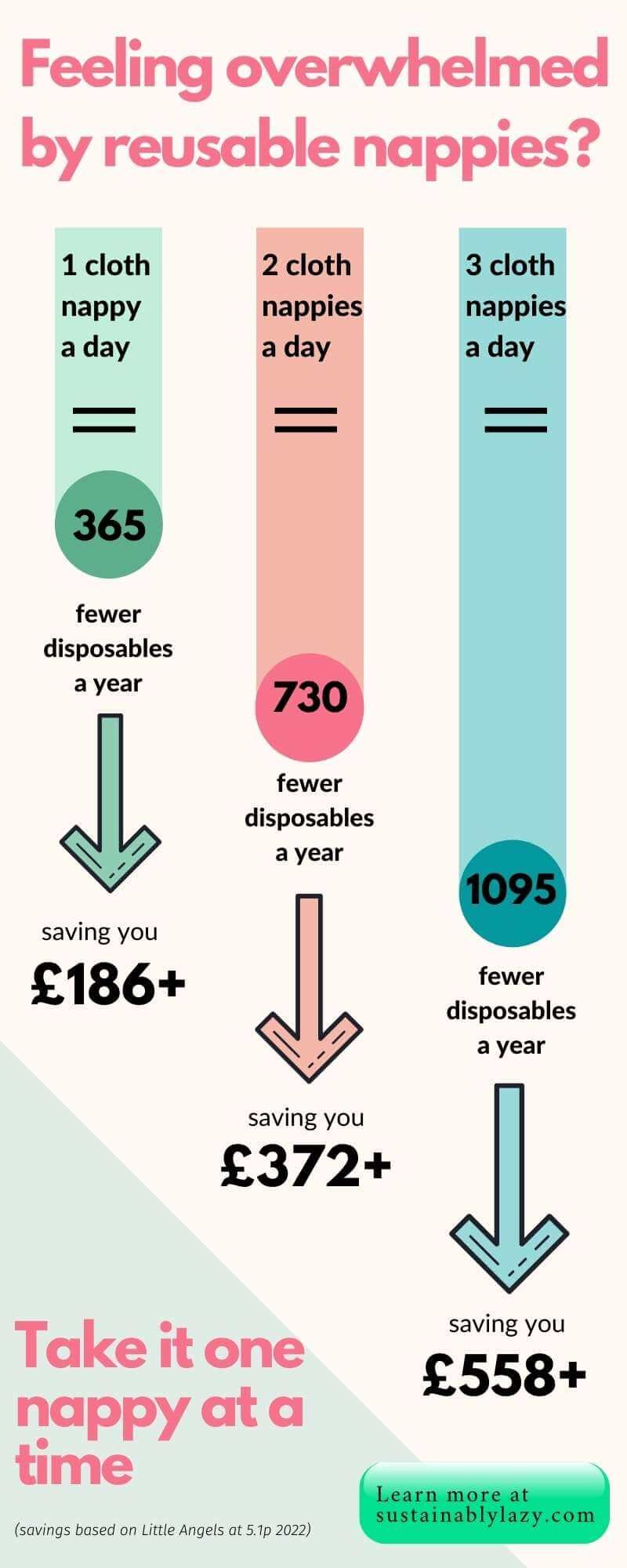Four Amazing Benefits of Using Cloth Nappies
This page contains an affiliate link
Well, the first time I was told about the benefits of cloth nappies, I’ll admit I was horrified.
I was pregnant with my first baby and doing my best to not think about cleaning pooey bums.
During a less nauseating trimester 2, I was curious enough to look them up. When I discovered the combined amount of waste that disposables produced I was horrified.
It was enough to get me digging for more information.
I learnt about the different types, read reviews, and watched people’s wash routines on YouTube.
After a while, it didn’t seem so overwhelming.
Now that I’ve had my baby, given cloth a go and found what works, I’m going to share some of the main benefits of using cloth nappies.
Don’t forget to check out the other reusable nappy articles in the parenting section of my site for more help getting started.
Four big benefits of cloth nappies
Knowing how the benefits really motivated me to learn everything I could about cloth diapers. Here are four reasons you should consider using washable diapers.
P.S You may have noticed I swap between the terms “diapers” and “nappies.” This is because my readers are split between the UK and the USA where different words are used. Using both terms means my website is more likely to show up in search engines.
1. The environmental impact.
Cloth nappies do require extra laundry but they are still better for the environment than disposables when you consider the entire lifecycle of the product.
An estimated 167 million disposable nappies are produced every year which requires 248.5m barrels of crude oil.
Crude oil is a fossil fuel and extracting it from the Earth is the main cause of climate change. Mixed with human waste, disposable nappies are very hard to recycle and are usually dumped in landfills or incinerated. Disposable nappies also end up in the ocean.
I feel I have a responsibility to my children to fight for their future and that means reducing my family's waste as much as I am able.
The key word here is “able.” Using cloth nappies full time requires a level of privilege that not everyone has and guilting people into trying to use them is not what I want to do.
If cloth diapers are proving challenging to you, for whatever reason, then please give yourself a break. It isn’t all of nothing and it’s perfectly fine to use a mixture of both.
Source - A Circular Economy For Nappies by the Ellen Macarthur Foundation, Oct 2020.
2. Cloth nappies are cost-effective.
Cloth diapers are very cost-effective. Now that I’ve found which brands and styles work for us, I should be set until potty training. This is a massive advantage of reusable products.
The upfront cost is the hardest part, especially for parents on a low income who don’t have a few hundred to spend at once.
We were lucky and managed to get a second-hand bundle of washable nappies on eBay (including a bucket, boosters and liners). We ended up buying quite a few more (new and preloved) because of the extra challenges we faced with a low birth weight preemie.
There are ways to reduce upfront costs of cloth nappies including:
Check if your council offers reusable nappy vouchers - many do
Buy preloved or borrow off friends
Choose a budget nappy system like terries and wool wraps
Buy one nappy a month (or whatever frequency is possible for you)
Ask for cloth nappies at a baby shower or instead of teddies and clothes at birth
Once you’ve finished with your nappies, you should be able to sell them on (not all of mine have been okay after 2 years, mainly the ones with Velcro but this can be replaced).
If you can’t afford to buy a stash of nappies, or if you’re struggling to use reusable for a different reason, remember this:
1 cloth nappy a day = 365 fewer disposable nappies a year saving you £186+
2 cloth nappies a day = 730 fewer disposable nappies a year, saving you £372+
3 cloth nappies a day = 1095 fewer disposable nappies a year, saving you £558+
It doesn’t have to be all or nothing. You can start with one or two and see how you get on.
Rather than putting pressure on ourselves to achieve perfection, we all need to focus on making changes that are sustainable for us as a family.
One thing you can do is tell your friends about the benefits of cloth nappies just so they know it’s an option. Collective group change is much more powerful than individual change.
2. The chemicals in disposables nappies
A French study in 2019, found 60 hazardous chemicals in disposable nappies, some of which were banned in the European Union and most of which you wouldn’t want near your baby’s skin or genitals.
Some of the chemicals found were:
Pesticides
Glyphosate (a weed killer that’s toxic to bees)
Formaldehyde
Dioxins
Naphthalene (a banned carcinogenic)
Dichlorobenzenes (a VOC that causes cancer in animals)
Toluene (VOC and benzene derivative used in paint thinner)
Artificial fragrance allergens
Substances found in cigarette smoke and diesel fumes
While this sounds scary, the report states there is no immediate health impact on the child and parents are safe to continue using them. However, it’s enough to put me off using disposables for more than temporary episodes when it’s the most practical option for my family.
No nappy manufacturers were named in the report, but Pampers did respond to say “our products do not contain any of the allergens listed by the European Union” as published in the Guardian.
Source: Sécurité des couches pour bébé, Anges, 2019
3. Better for sensitive skin
Cloth nappies are better for sensitive skin - provided you’ve got a good wash routine. If you’re getting nappy rash while using washable nappies, it’s likely you need to make an adjustment.
In the NICU, we used pampers micro with my son (which were way too big for him) and they gave him nappy rash, even when using a barrier cream. This broke my heart as his delicate skin should have been protected inside my womb, but using washable nappies wasn't an option for us at first.
Once we swapped to cloth nappies and fixed our wash routine, we stopped getting nappy rash altogether and it’s never been an issue with my second baby.
Nappy rash can also be caused by preservatives in disposable wet wipes. If a product uses water (like Water Wipes) it needs a preservative to stop bacteria from forming. That 1% that isn’t water could be a pesticide, like Benzalkonium Chloride (the disinfectant in Zoflora!), which could cause a nasty rash on your baby’s bottom. So keep an eye out for that if you’re experiencing any persistant nappy rash.
Resources for getting started with cloth nappies
Pin this to your cloth nappy Pinterest board:
If you’d like to learn more about cloth nappies, here are some links you may find helpful:
Which type of cloth nappy should you choose?
A beginner’s guide to newborn cloth nappies
Where to buy washable nappies, wipes and accessories:
The Nappy Gurus* sell a large variety of cloth nappies, reusable menstrual products and popular eco-friendly lifestyle products. They also offer starter bundles depending on your budget.
*Use my affiliate code SUSTAINABLYLAZY for 10% off
You can also check Facebook groups and eBay for people selling them second-hand.
Are you thinking about trying out cloth nappies? What is your main motivation and what’s holding you back?






